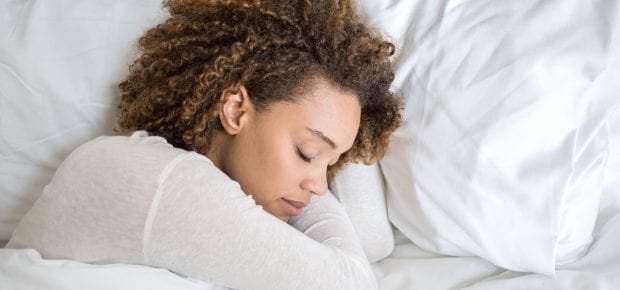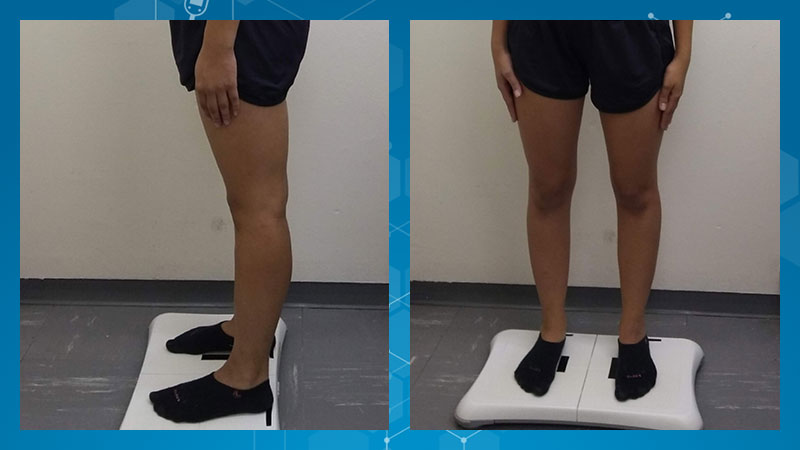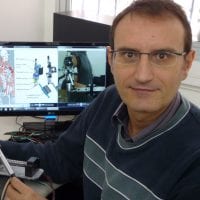April 22, 2021
Do you ever wake up in the morning feeling groggy, sluggish and almost as if you didn’t get any rest at all? It’s more common than you might think. Sleep technology that monitors sleep quality over sleep quantity might be your answer to helping you understand how to feel more restful and energized in the morning.
Getting adequate sleep is just as important as getting enough water and food throughout the day — it is an essential basic need and necessary for achieving your most productive and healthiest self.
Yet, insomnia and other sleep-related conditions only seem to be increasing in our society. The Centers for Disease Control and Prevention has found about 70 million Americans suffer from chronic sleep problems. The CDC also reports that those with chronic sleep disorders are more likely to report other conditions, such as heart disease, stroke, asthma and cancer.
Using Technology for Sleep Research
Using technology for sleep research to better understand our nightly patterns are not new topics in the science, healthcare and engineering communities. But great strides have been made in recent years to understand the importance of quality sleep and its impact on our overall health.
A study published in IEEE xplore found that sleep quality is directly related to sleep posture: “Supine sleeping positions [lying on your back] will not suppress organs and can effectively relieve symptoms of pain in the neck and back. However, this kind of sleeping posture is easy to lead to the fall of the tongue root and block breathing, which is not suitable for people who often snore or have respiratory diseases.
Lying on the right side is conducive to the normal operation of the gastrointestinal tract and will not compress the heart, but it can affect the movement of the right lung.”
IEEE Senior Member Arturo Forner-Cordero also recently published research on the connection between sleep and gait, or the way we walk and stand.
“We looked into chronic sleep deprivation, classified as several nights sleeping less than necessary, and social jet-lag, that is the change in the sleeping hours between work days and free days, such as going to sleep later and waking up later on weekends,” says Forner-Cordero. “We found that this phenomenon also affects postural control as well as other motor tasks, such as reaching tasks and gait.”
To understand this connection, Forner-Cordero used a balance board, a widely available fitness tool you stand on while performing exercises to help improve balance and posture. The eight participants stepped on their balance board before and after one night of sleep deprivation –– with their eyes open, and then with their eyes closed.
The balance board uses sensors to detect and monitor our gait, our balance and our micro-movements.
“The force sensors on the balance board can evaluate the position of the Center of Pressure (CoP) due to the vertical forces,” explains Forner-Cordero. “This CoP provides a measure of the control of posture.”
The results showed that sleep deprivation was more pronounced without visual information and impacted the mean sway in the anterior-posterior direction and its distribution variation. This confirmed Forner-Cordero’s theory that sleep deprivation impacts our gait.
Sleep Technology for Consumers
People are now taking their preventative health into their own hands and reaching for consumer sleep technology products to help them understand how to improve their sleep habits and to reach better self-care equilibrium.
The most common type of commercial sleep tracker is a wearable, often in the form of a watch that is worn while the user sleeps.
Tracking technologies use accelerometers that monitor our movements throughout the night and then make assumptions on our sleep stage, equating less movement to deeper sleep. A recent article from IEEE’s Engineering in Medicine and Biology Society explains that newer trackers currently on the market are getting slightly better at integrating additional physiological measurements.
The article states that “since our temperature, blood pressure and heart rate tend to drop during non-rapid eye movement (REM) sleep, devices that measure the heart’s beats per minute (BPM) may have a better chance at pinpointing sleep stages. Additionally, during REM (dreaming) sleep, the sleeper is typically paralyzed but has an unstable pulse, so an algorithm could look for low movement and varying pulse rate to differentiate REM sleep. But, these metrics are still only inferring sleep.”
While a smartwatch might help you keep track of your sleep, the technology is still developing in order to accurately assess the quality you receive every night.
See also Why Your Smartwatch Data is So Valuable to Cyber Attackers
Some wearables can also be worn as headbands that can track and detect resting periods from our brainwaves. Though slightly more accurate with its method of tracking, consumers have found the headband to be uncomfortable and difficult to sleep with throughout the night.
Overall, commercial wearables are useful tools for healthy people to pay attention to their sleeping habits. Yet, they currently cannot objectively assess sleep disorders. More in-depth technology used by doctors will best help a patient understand if a serious condition is at play.






 Liquid Infrastructure: Our Planet's Most Precious Resource
Liquid Infrastructure: Our Planet's Most Precious Resource The Impact of Technology in 2025
The Impact of Technology in 2025 Quantum and AI: Safeguards or Threats to Cybersecurity?
Quantum and AI: Safeguards or Threats to Cybersecurity? Why AI Can't Live Without Us
Why AI Can't Live Without Us Bits, Bytes, Buildings and Bridges: Digital-Driven Infrastructure
Bits, Bytes, Buildings and Bridges: Digital-Driven Infrastructure Impact of Technology in 2024
Impact of Technology in 2024 Emerging AI Cybersecurity Challenges and Solutions
Emerging AI Cybersecurity Challenges and Solutions The Skies are Unlimited
The Skies are Unlimited Smart Cities 2030: How Tech is Reshaping Urbanscapes
Smart Cities 2030: How Tech is Reshaping Urbanscapes Impact of Technology 2023
Impact of Technology 2023 Cybersecurity for Life-Changing Innovations
Cybersecurity for Life-Changing Innovations Smarter Wearables Healthier Life
Smarter Wearables Healthier Life Infrastructure In Motion
Infrastructure In Motion The Impact of Tech in 2022 and Beyond
The Impact of Tech in 2022 and Beyond Cybersecurity, Technology and Protecting Our World
Cybersecurity, Technology and Protecting Our World How Technology Helps us Understand Our Health and Wellness
How Technology Helps us Understand Our Health and Wellness The Resilience of Humanity
The Resilience of Humanity Harnessing and Sustaining our Natural Resources
Harnessing and Sustaining our Natural Resources Creating Healthy Spaces Through Technology
Creating Healthy Spaces Through Technology Exceptional Infrastructure Challenges, Technology and Humanity
Exceptional Infrastructure Challenges, Technology and Humanity The Global Impact of IEEE's 802 Standards
The Global Impact of IEEE's 802 Standards Scenes of our Cyber Lives: The Security Threats and Technology Solutions Protecting Us
Scenes of our Cyber Lives: The Security Threats and Technology Solutions Protecting Us How Millennial Parents are Embracing Health and Wellness Technologies for Their Generation Alpha Kids
How Millennial Parents are Embracing Health and Wellness Technologies for Their Generation Alpha Kids Space Exploration, Technology and Our Lives
Space Exploration, Technology and Our Lives Global Innovation and the Environment
Global Innovation and the Environment How Technology, Privacy and Security are Changing Each Other (And Us)
How Technology, Privacy and Security are Changing Each Other (And Us) Find us in booth 31506, LVCC South Hall 3 and experience the Technology Moon Walk
Find us in booth 31506, LVCC South Hall 3 and experience the Technology Moon Walk Virtual and Mixed Reality
Virtual and Mixed Reality How Robots are Improving our Health
How Robots are Improving our Health IEEE Experts and the Robots They are Teaching
IEEE Experts and the Robots They are Teaching See how millennial parents around the world see AI impacting the lives of their tech-infused offspring
See how millennial parents around the world see AI impacting the lives of their tech-infused offspring Take the journey from farm to table and learn how IoT will help us reach the rising demand for food production
Take the journey from farm to table and learn how IoT will help us reach the rising demand for food production Watch technical experts discuss the latest cyber threats
Watch technical experts discuss the latest cyber threats Explore how researchers, teachers, explorers, healthcare and medical professionals use immersive technologies
Explore how researchers, teachers, explorers, healthcare and medical professionals use immersive technologies Follow the timeline to see how Generation AI will be impacted by technology
Follow the timeline to see how Generation AI will be impacted by technology Learn how your IoT data can be used by experiencing a day in a connected life
Learn how your IoT data can be used by experiencing a day in a connected life Listen to technical experts discuss the biggest security threats today
Listen to technical experts discuss the biggest security threats today See how tech has influenced and evolved with the Games
See how tech has influenced and evolved with the Games Enter our virtual home to explore the IoT (Internet of Things) technologies
Enter our virtual home to explore the IoT (Internet of Things) technologies Explore an interactive map showcasing exciting innovations in robotics
Explore an interactive map showcasing exciting innovations in robotics Interactively explore A.I. in recent Hollywood movies
Interactively explore A.I. in recent Hollywood movies Get immersed in technologies that will improve patients' lives
Get immersed in technologies that will improve patients' lives